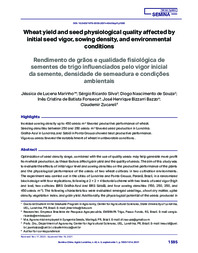Wheat yield and seed physiological quality affected by initial seed vigor, sowing density, and environmental conditions.
Wheat yield and seed physiological quality affected by initial seed vigor, sowing density, and environmental conditions.
Author(s): MARINHO, J. de L.; SILVA, S. R.; SOUZA, D. N. DE; FONSECA, I. C. DE B.; BAZZO, J. H. B.; ZUCARELI, C.
Summary: Optimization of seed density range, combined with the use of quality seeds may help generate more profit from wheat production, as these factors affect grain yield and the quality of seeds. The aim of this study was to evaluate the effects of initial vigor level and sowing densities on the productive performance of the plants and the physiological performance of the seeds of two wheat cultivars in two cultivation environments. The experiment was carried out in the cities of Londrina and Ponta Grossa, Paraná, Brazil, in a randomized block design with four replications, following a 2 × 2 × 4 factorial scheme with two levels of seed vigor (high and low), two cultivars (BRS Gralha-Azul and BRS Sabiá), and four sowing densities (150, 250, 350, and 450 seeds m-2). The following characteristics were evaluated: emerged seedlings, shoot dry matter, spike density, vegetation index, and grain yield. Additionally, the physiological potential of the seeds produced in Londrina was evaluated by first germination count, germination, accelerated aging, seedling emergence, and emergence speed index tests. The increase in density up to 450 seeds m-2 favored the productive performance of the crop in both cultivation environments; however, it reduced the physiological performance of the seeds produced in Londrina. The cultivars BRS Gralha-Azul and BRS Sabiá had better performance and grain yield in Londrina and Ponta Grossa, respectively. High-vigor seeds favored the establishment of the stand, especially under unfavorable environmental conditions. Key words: Germination. Plant population. Seed quality. Triticum aestivum L.
Publication year: 2021
Types of publication: Journal article
Unit: Embrapa Wheat
Keywords: Aspecto Fisiológico, Densidade de Semeadura, Fisiologia, Grão, Semeadura, Semente, Trigo
Observation
Some of Embrapa's publications are published as ePub files. To read them, use or download one of the following free software options to your computer or mobile device. Android: Google Play Books; IOS: iBooks; Windows and Linux: Calibre.
Access other publications
Access the Agricultural Research Database (BDPA) to consult Embrapa's full library collection and records.
Visit Embrapa Bookstore to purchase books and other publications sold by Embrapa.

